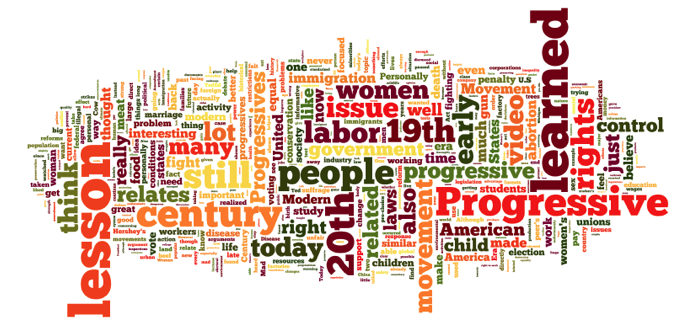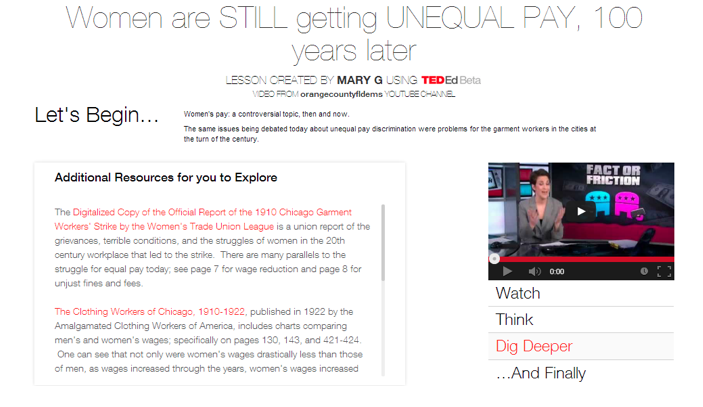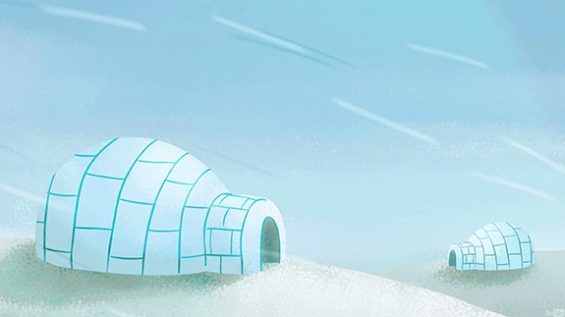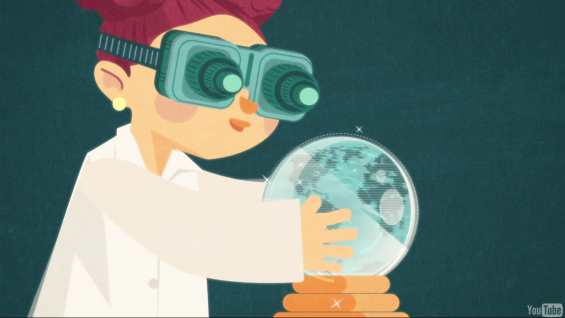
Using TED-Ed in an AP United States History Classroom

With billions of videos on YouTube at a teacher’s disposal, there are billions of ways a teacher could utilize TED-Ed in the classroom. Here is the story of one teacher, Anna Searcy. Anna has been teaching for nearly 15 years and has been at her current school, Northside College Preparatory High School in Chicago, since 2002.
A classroom project: After studying the American Progressive movement, I wanted my students to explore the notion of current Progressive movements. I asked them, ‘Who are today’s progressives? What are the issues, problems, or controversies today that Americans look to the federal government, or elsewhere, to address? How do Americans want to improve our society?’ My goal was to have students discover that historical movements are not static but, rather, a continuum. The ideal is to find legitimacy in historical study by finding direct links from the past to the present. Additionally, I wanted to give students ownership over their findings, so I left the question open-ended.
I was encouraging students to explore the full spectrum of their own passions and beliefs, and I was also allowing students to work as individuals or in partnerships. To address the needs of 89 different students, I needed an environment that allowed for personalization, creativity, and ease of use. Additionally, I wanted my students to defend their arguments and educate their peers, but, in the AP calendar, I had limited time to allow for full presentations.
Collaborating on TED-Ed: By creating a project that could exist in the cloud, my students explored their peers’ Lessons outside of a traditional face-to-face presentation and at their own pace. Ted-Ed was a natural choice for me to frame this project: Having completed TED-Ed activities in the past, my students were used to the process already. Since they were now the teachers, why not let them be the brains behind their own Ted-Ed activities?
Student as Teacher: My students were already registered with Ted-Ed and were familiar with the format. I created and presented an instruction set that explained the objectives, assessment, and procedure to my students. I also created a screencast of how to create a Ted-Ed activity and posted it to YouTube for my students who might need a little technical help. Students were assessed on a few factors. Most importantly, I was looking for their argument to draw the link from the Progressive movement to their contemporary issue. This was presented in their Introduction, And Finally, and Dig Deeper sections. I also assessed them on accuracy of historical information and inclusion of related primary sources in their Dig Deeper section.

Student as Student: I created a Google Form for my classes to submit links and descriptions of their activities. Once I assessed the projects, I made a copy of the spreadsheet and project links and shared that spreadsheet with my students. At the end of our Progressive Era unit, I assigned the student Ted-Ed Lessons to their peers in class. Students could choose any of the Lessons that appealed to them, and they were able to complete two to three activities in class. As a final assessment, they submitted e a reflection on whether they agreed with their peers’ argument about the link between the Progressive Era and the contemporary issue, and they also explained what new information they learned and personal responses to the issue.
One Student’s Reflection:
Question: How did your peer’s Modern Progressives Lesson relate to our study of the 19th and early 20th Century Progressive movement? What did you learn? What’s your personal response to this lesson?
Response: Claire’s Modern Progressives Lesson on urban forests related to the arguments of the conservationists and the preservationists at the turn of the century. It is interesting to see the links to the past; Roosevelt wanted to conserve land so it could be used the most wisely. He wanted to run several projects on the same piece of land (for example: logging and grazing) so that people could get as much out of the land as possible. Today, urban forests are a way of adding greens space into an already existing city structure; the space now serves its regular function in addition to being a “forest” and gets the most out of the land. I learned that there are actually several economic benefits to the urban forest movement. For example, it saves money on shade and water drainage structures. It also raises property value. I thought this was very relevant to what Roosevelt was advocating for: planned use of the land to do as many things as possible. Personally, I am very supportive of the urban forest movement. I love forests, and nature in general. I think it is wonderful that people are taking steps to bring nature into everyday life.



